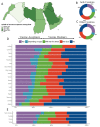Hesitancy of Arab Healthcare Workers towards COVID-19 Vaccination: A Large-Scale Multinational Study
- PMID: 34063313
- PMCID: PMC8147447
- DOI: 10.3390/vaccines9050446
Hesitancy of Arab Healthcare Workers towards COVID-19 Vaccination: A Large-Scale Multinational Study
Abstract
Background: Health care workers (HCWs) are at increased risk of acquiring and transmitting COVID-19 infection. Moreover, they present role models for communities with regards to attitudes towards COVID-19 vaccination. Hence, hesitancy of HCWs towards vaccination can crucially affect the efforts aiming to contain the pandemic. Previously published studies paid little attention to HCWs in Arab countries, which have a population of over 440 million.
Objectives: To assess the rates of COVID-19 vaccine hesitancy in Arabic-speaking HCWs residing in and outside Arab countries, and their perceived barriers towards vaccination.
Methods: A cross-sectional study based on an online survey was conducted from 14-29 January 2021, targeting Arabic-speaking HCWs from all around the world.
Results: The survey recruited 5708 eligible participants (55.6% males, 44.4% females, age 30.6 ± 10 years) from 21 Arab countries (87.5%) and 54 other countries (12.5%). Our analysis showed a significant rate of vaccine hesitancy among Arabic-speaking HCWs residing in and outside of Arab countries (25.8% and 32.8%, respectively). The highest rates of hesitancy were among participants from the western regions of the Arab world (Egypt, Morocco, Tunisia, and Algeria). The most cited reasons for hesitancy were concerns about side effects and distrust of the expedited vaccine production and healthcare policies. Factors associated with higher hesitancy included age of 30-59, previous or current suspected or confirmed COVID-19, female gender, not knowing the vaccine type authorized in the participant's country, and not regularly receiving the influenza vaccine.
Conclusion: This is the first large-scale multinational post-vaccine-availability study on COVID-19 vaccine hesitancy among HCWs. It reveals high rates of hesitancy among Arab-speaking HCWs. Unless addressed properly, this hesitancy can impede the efforts for achieving widespread vaccination and collective immunity.
Keywords: COVID-19 vaccines.
Conflict of interest statement
The authors declare that there is no conflict of interest.
Figures






Similar articles
-
A high rate of COVID-19 vaccine hesitancy in a large-scale survey on Arabs.Elife. 2021 May 27;10:e68038. doi: 10.7554/eLife.68038. Elife. 2021. PMID: 34042047 Free PMC article.
-
COVID-19 vaccine hesitancy among healthcare workers in Arab Countries: A systematic review and meta-analysis.PLoS One. 2024 Jan 2;19(1):e0296432. doi: 10.1371/journal.pone.0296432. eCollection 2024. PLoS One. 2024. PMID: 38166119 Free PMC article.
-
COVID-19 Vaccine Hesitancy Among Health Care Workers in Thailand: The Comparative Results of Two Cross-Sectional Online Surveys Before and After Vaccine Availability.Front Public Health. 2022 Aug 1;10:834545. doi: 10.3389/fpubh.2022.834545. eCollection 2022. Front Public Health. 2022. PMID: 35979452 Free PMC article.
-
Predictors of COVID-19 vaccine hesitancy among Egyptian healthcare workers: a cross-sectional study.BMC Infect Dis. 2021 Aug 5;21(1):762. doi: 10.1186/s12879-021-06392-1. BMC Infect Dis. 2021. PMID: 34353279 Free PMC article.
-
Hesitancy Over the COVID-19 Vaccine Among Various Healthcare Workers: An International Narrative Review.Cureus. 2024 Jan 27;16(1):e53059. doi: 10.7759/cureus.53059. eCollection 2024 Jan. Cureus. 2024. PMID: 38410316 Free PMC article. Review.
Cited by
-
Association between close interpersonal contact and vaccine hesitancy: Findings from a population-based survey in Canada.Front Public Health. 2022 Oct 4;10:971333. doi: 10.3389/fpubh.2022.971333. eCollection 2022. Front Public Health. 2022. PMID: 36267997 Free PMC article.
-
Knowledge, Attitudes, and Practices of Healthcare Workers in Jordan towards the COVID-19 Vaccination.Vaccines (Basel). 2022 Feb 9;10(2):263. doi: 10.3390/vaccines10020263. Vaccines (Basel). 2022. PMID: 35214721 Free PMC article.
-
Influence of Psychological Factors on Vaccination Acceptance among Health Care Workers in Slovenia in Three Different Phases of the COVID-19 Pandemic.Vaccines (Basel). 2022 Nov 22;10(12):1983. doi: 10.3390/vaccines10121983. Vaccines (Basel). 2022. PMID: 36560393 Free PMC article.
-
The impact of health status on attitudes toward COVID-19 vaccination.Health Sci Rep. 2022 Jul 20;5(4):e744. doi: 10.1002/hsr2.744. eCollection 2022 Jul. Health Sci Rep. 2022. PMID: 35873399 Free PMC article.
-
Did Italy Really Need Compulsory Vaccination against COVID-19 for Healthcare Workers? Results of a Survey in a Centre for Maternal and Child Health.Vaccines (Basel). 2022 Aug 10;10(8):1293. doi: 10.3390/vaccines10081293. Vaccines (Basel). 2022. PMID: 36016179 Free PMC article.
References
-
- Mohamed-Hussein A.A., Makhlouf H., Abd El Aal H., Kholief K., Saad M.M., Abdellal D.A. A national survey of potential acceptance of COVID-19 vaccines in healthcare workers in Egypt. medRxiv. 202110.1101/2021.01.11.21249324
LinkOut - more resources
Full Text Sources
Medical

